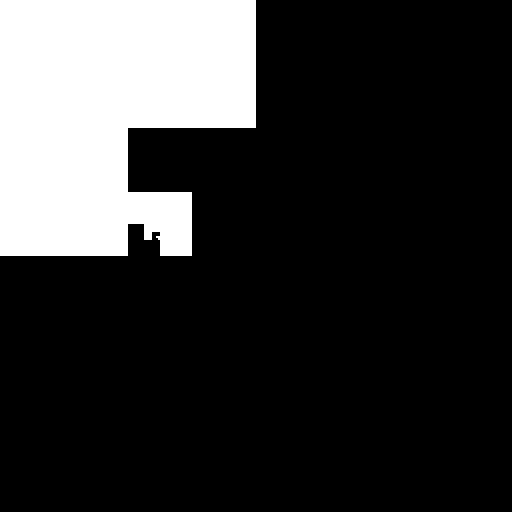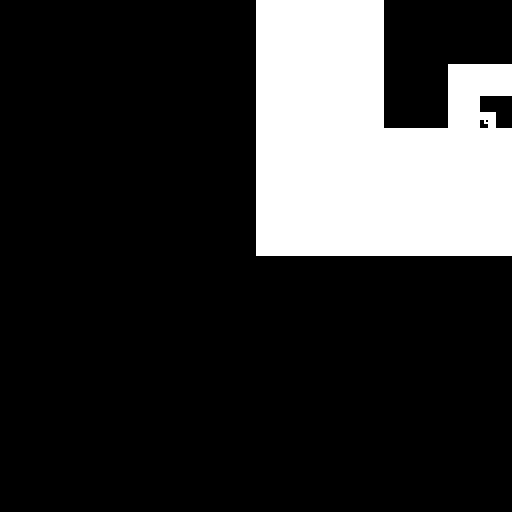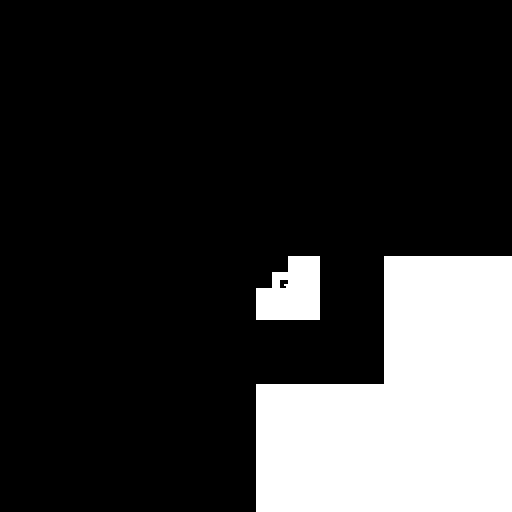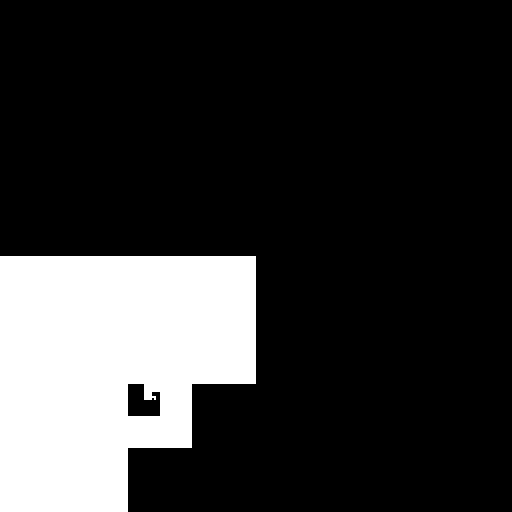TIAS
Time Is A Square
TIAS is an abstract video artwork and experimental time display.
TIAS offers an alternative perception of time.
Time doesn’t elapse. The impression of time “passing by” is manmade. TIAS distances itself from a purely linear perception of time and allows the user to perceive time as an area or a picture.
–
TIAS translates a static picture into an endless abstract film. Emanating from Kazimir Malevich’s legendary painting “Black Square”, the film generates perpetual movement through a sequence of individual pictures. The degree of abstraction reached by Malevich is brought into the present using technical possibilities. Furthermore, the basic square form corresponds exactly to the smallest digital unit of image representation, the pixel, while the contrast between black and white is a direct translation of the binary foundation of digital technology.
TIAS’s basic time unit is predictable and alike for all people; the day. The black square area represents the duration of one day. All other units result as a division of the basic square into four equal square parts. The white square area denotes the present quarter of the day. In the first quarter of the day the white square is to the upper left, in the second quarter to the upper right, in the third to the lower right and in the fourth quarter of the day to the lower left. Thus a tangible image representing the respective part of the day appears four times a day.
Further divisions of a similar nature follow, enabling the perception of movement. In the process, each current square is marked with the opposite color of the primary level. Thus a unique picture evolves for every time of the divided day, made up of alternating black and white squares systematically changing into each other. A mathematical fractal.
Existing time measurement assumes that time is linear and principally shows the present time. TIAS understands time as not immediately between the past and the future. The two dimensional representation depicts both experienced, as well as not yet experienced time. Time itself becomes a multi dimensional dimension. In tangible terms, it becomes an area. Numerical breakdown of the pattern, or in other words, the naming of a particular time of the day, is still possible: as in “let’s meet at 32 34” or “see you later, in the fourth quarter!”
TIAS’s fractal system is almost infinitely expandable into smaller or larger time periods. The portrayable time is only limited by the size of the medium in which it should be presented. Using the iPhone zoom function, the day can be zoomed into or out of. The minimum time period available is 1/1.048.576 of a day, which roughly equates to a second. The maximum time period available for the QT1.0 version is 1.048.576, or about 2873 years.
The fictional starting point of TIAS is at 0.00h (Petrograd time) on the 19th December in 1915, is ment as a reference to Malevich and the time and place of the exhibition opening in which Black Square was first presented.
2143
Temporal reference & detailed explanation
A day is a day!
The fundamental time unit in TIAS is the day. The day is a simple astronomical phenomenon, existing in every culture and every era as the basic unit of time measurement. Divisions such as hours and minutes are, in contrast, random and based on cultural agreement. The fractions 1/24, 1/60, are not an inevitable result of dividing the time unit “day”.
In TIAS the black square area represents the duration of a day.

From stills to film
All smaller units result as a division of the basic square into four equal square parts. Three parts are black, the fourth is white. The white square area denotes the present quarter of the day. In the first quarter of the day the white square is to the upper left, in the second quarter to the upper right, in the third to the lower right and in the fourth quarter of the day to the lower left. This system of highlighting the present period of time, continues within the smaller square divisions with ever opposing colours. Thereby the stills appear to move.

Four pictures depicting the first level (detailed view)
A tangible image representing the respective part of the day appears four times a day.
The film now has four pictures per day.
Further divisions of a similar nature follow, resulting in the perception of movement. (see following examples). In the process, each current square is marked with the opposite color of the primary level. Thus a unique picture evolves for every time of the divided day, made up of alternating black and white squares systematically changing into each other. A mathematical fractal.

Four pictures of the second level, here pictured in the first square of the first level (detailed view)
The film now has 16 pictures per day.

Four further pictures depicting the second level in the second, third and fourth quarters (detailed view)
In TIAS, each day has 8 sub levels. Thereby 65536 individual pictures are created per day, each showing one 65536th of a day as a unique graphic pattern. In existing time measurement a day has 86400 seconds, for human perception, a negligible difference, thus one second and the smallest unit in the TIAS clock appear to be of a similar length of time.

Default setting:
The day begins with the first time period after midnight.
(Timecode 1111 1111)

Example 1:
It’s early in the morning. The third quarter of the first quarter of the day is coming to an end.
(Timecode 1344 2334)

Example 2:
Early morning.
(Timecode 2233 4422)

Example 3:
Shortly after midday.
(Timecode 3111 3334)

Example 4:
Evening. The third quarter of the last quarter of the day begins.
(Timecode 4321 2344)
On the following day the procedure is repeated, however in an imaginary square on an upper level, which represents the area of four days. The second day is positioned in the upper right corner of the area, the third day in lower right, the fourth day in the lower left corner of the area. Once the divisions have run through each of the four squares, four days have elapsed. The system is thus infinitely repeatable. Although the pattern for each day is the same, the whole pattern never repeats itself. (The four day square moves to its next unique position within a sixteen day square, which in turn moves to its next unique position within a sixty-four day square and so on.)
–
Soon available again at App-Store and at Google Play.
The TIAS application allows for the representation of between a day (default setting) and up to a time frame of 1,048,579 days. It is also possible to depict the 1,048,576th part of a day. Each step moves into the next larger or smaller square, continually changing color.
The zoom functions as usual with two fingers. These steps are also controllable using the menu bar.
Moving two fingers away from each other, zooms into the graphic. The time representation becomes more accurate and TIAS moves faster.
In Menu: zoom.
Moving two fingers towards each other, zooms out of the graphic. The time representation encompasses a longer time period.
In Menu: extend.
Under the menu position “one day” the settings go back to the default setting of a day.
Under the TIAS icon further settings can be found for TIAS.
The TIAS-time-index shows the numerical translation of the graphic representation, together with the actual time period of the currently pictured square in the upper left area of the display.
–
TIAS will continue to be developed in the future.
Time can also be translated as a cube. Malevich’s “Black Square” could also have been a sculpture.
Find first illustrations and ideas to a three dimensional model at the end of this page.
ALON
A List Of Numbers
The TIME IS A SQUARE (TIAS) default setting has 8 subdivisions.
A single day, as defined by the fixed size of the basic square, is itself composed of 65536 of the smallest displayed units (compared to 86400 seconds in a day, as defined by existing time measurement).
Let’s talk about ONE day — Zoom units in summary
Well, there is more than ONE day — Extended units in summary
MATH
{(x,y)} = ({0,1} x/2, {0,1} y/2)
A single day, as defined by the fixed size of the basic square, is itself composed of 65536 of the smallest displayed units (compared to 86400 seconds in a day, as defined by existing time measurement). TIAS is based on a mathematical fractal {(x,y)} = ({0,1} x/2, {0,1} y/2) and is almost infinitely expandable into smaller or larger time periods. The patterns are always similar but never the same.



